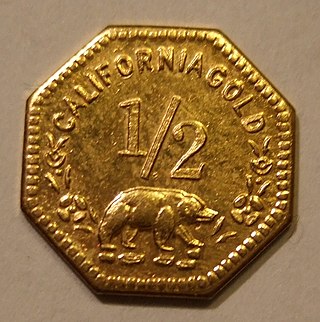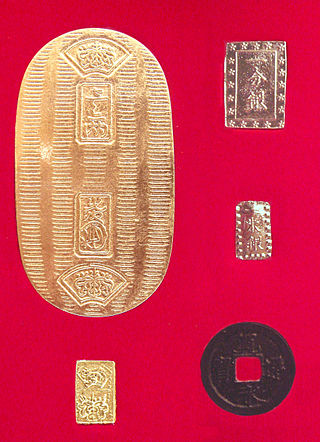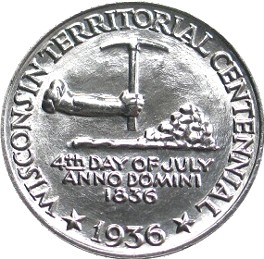Coins of the United States dollar, aside from those of the earlier Continental currency were first minted in 1792. New coins have been produced annually and they make up a valuable aspect of the United States currency system. Circulating coins exist in denominations of 1¢, 5¢, 10¢, 25¢, 50¢, and $1.00. Also minted are bullion, including gold, silver and platinum, and commemorative coins. All of these are produced by the United States Mint. The coins are then sold to Federal Reserve Banks which in turn are responsible for putting coins into circulation and withdrawing them as demanded by the country's economy.

The Coinage Act of 1849 was an Act of the United States Congress passed during the California Gold Rush authorizing the Mint to produce two new gold coins in response to the increased gold supply: the small gold dollar and the large double eagle worth twenty dollars. The Act also defined permissible variances in gold coinage.

The penny of Great Britain and the United Kingdom from 1714 to 1901, the period in which the House of Hanover reigned, saw the transformation of the penny from a little-used small silver coin to the bronze piece recognisable to modern-day Britons. All bear the portrait of the monarch on the obverse; copper and bronze pennies have a depiction of Britannia, the female personification of Britain, on the reverse.

The Dahlonega Mint was a former branch of the United States Mint built during the Georgia Gold Rush to help the miners get their gold assayed and minted, without having to travel to the Philadelphia Mint. It was located at in Dahlonega, Lumpkin County, Georgia. Coins produced at the Dahlonega Mint bear the "D" mint mark. That mint mark is used today by the Denver Mint, which opened in 1906, over four decades after the Dahlonega Mint closed. All coins from the Dahlonega Mint are gold, in the $1, $2.50, $3, and $5 denominations, and bear dates in the range 1838–1861.

The United States Mint is a bureau of the Department of the Treasury responsible for producing coinage for the United States to conduct its trade and commerce, as well as controlling the movement of bullion. The U.S. Mint is one of two U.S. agencies that produce money in the case of minting coinage; the other is the Bureau of Engraving and Printing, which prints paper currency. The first United States Mint was created in Philadelphia in 1792, and soon joined by other centers, whose coins were identified by their own mint marks. There are currently four active coin-producing mints: Philadelphia, Denver, San Francisco, and West Point.

A double eagle is a gold coin of the United States with a denomination of $20. The coins are 34 mm × 2 mm and are made from a 90% gold and 10% copper alloy and have a total weight of 1.0750 troy ounces.

The Coinage Act of 1792, passed by the United States Congress on April 2, 1792, created the United States dollar as the country's standard unit of money, established the United States Mint, and regulated the coinage of the United States. This act established the silver dollar as the unit of money in the United States, declared it to be lawful tender, and created a decimal system for U.S. currency.

Beaver Coins, also known in pioneer days as Beaver Money, were gold coins minted in Oregon in 1849. Their name comes from the prominent beaver depicted on the obverse of the coins. The currency contained 8% more gold than contemporary coins from the United States of America. Today these coins are quite rare and valuable.

The Charlotte Mint was the first United States branch mint. It was located in Charlotte, North Carolina and specialized in gold coinage.
The Manila Mint was a coinage mint that briefly served as a branch of the United States Mint, located in Manila, now the capital city of the Philippines.

The gold dollar or gold one-dollar piece is a gold coin that was struck as a regular issue by the United States Bureau of the Mint from 1849 to 1889. The coin had three types over its lifetime, all designed by Mint Chief Engraver James B. Longacre. The Type 1 issue has the smallest diameter of any United States coin minted to date.
The history of currency in the British colony of St. Kitts closely follows that of the British Eastern Caribbean territories in general. Even though Queen Anne's proclamation of 1704 brought the gold standard to the West Indies, silver pieces of eight continued to form a major portion of the circulating currency right into the latter half of the nineteenth century.

California gold coinage is a broad category of privately-issued coin-like items that were used in place of official currency in the United States territory of California during the gold rush of 1849. Since the federal government reserves the right to issue legal tender coins, California gold coinage is a misnomer and actually references coin-like ingots with a stated tender value, tokens with a stated tender value (denominated), and tokens without a stated tender value (non-denominated). These items are only classified as an ingot if the value of the metal was close to the tender value marked on the piece. In spite of the misnomer, it is common practice among numismatists to label coin-like ingots and denominated tokens as 'coins' while labeling the non-denominated tokens as 'tokens'. Also, the small California Gold coins and tokens have been made in many locations other than California, often with a claim of being from California on the piece and these items are generally labeled as California Gold Coins or Tokens.

Tokugawa coinage was a unitary and independent metallic monetary system established by shōgun Tokugawa Ieyasu in 1601 in Japan, and which lasted throughout the Tokugawa period until its end in 1867.

James Barton Longacre was an American portraitist and engraver, and the fourth chief engraver of the United States Mint from 1844 until his death. Longacre is best known for designing the Indian Head cent, which entered commerce in 1859, and for the designs of the Shield nickel, Flying Eagle cent and other coins of the mid-19th century.

Edgar Holmes Adams was an American competition diver and swimmer, numismatic scholar, author, coin collector and dealer.

The Liberty Head double eagle or Coronet double eagle is an American twenty-dollar gold piece struck as a pattern coin in 1849, and for commerce from 1850 to 1907. It was designed by Mint of the United States Chief Engraver James B. Longacre.

The Wisconsin Territorial Centennial half dollar is a commemorative half dollar designed by David Parsons and Benjamin Hawkins and minted by the United States Bureau of the Mint in 1936. The obverse depicts a pick axe and lead ore, referring to the lead mining in early Wisconsin, while the reverse depicts a badger and the territorial seal.

The Coinage Act of 1853, 10 Stat. 160, was a piece of legislation passed by the United States Congress which lowered the silver content of the silver half dime, dime, quarter dollar, and half dollar, and authorized a three dollar gold piece. Although intending to stabilize the country's silver shortage, it, in effect, pushed the United States closer to abandoning bimetallism entirely and adopting the gold standard.

The Mormon gold coinage consisted of privately-issued tokens which the Church of Jesus Christ of Latter-day Saints struck from 1848 to 1860. They were issued in $2.50, $5, $10, and $20 denominations.














